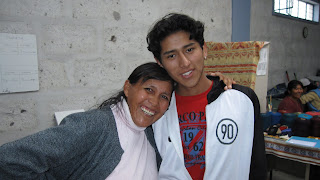Ayer (yesterday) - Chuck full of interesting transitions. Lauren, Steve, Maria, and I started out the morning journeying down to Mundo Alpaca, the (ritzy) warehouse where the
tejedores (knitters) buy their yarn. Once there my morning quickly changed from simply getting the colors of yarn that Andrea and I had decided upon (most of which they no longer had in stock) to making color decisions all over again. A seemingly easy task yet when you're dealing with muchos colores it becomes delightfully boggling. As it turned out, they did not take credit cards, only cash, and so I put
los conos de lana (the cones of yarn) on hold.
Next we went to the marketplace closer to el centro so Lauren and Steve could buy 100 toothbrushes and toothpaste tubes for the preschool students. Lauren and Steve are putting together little packets for each student so they can learn good teeth practices. While there, we (of course) also visited the aisle of fruit vendors to restock on
dulce mangoes and took a gander at the bull testicles for sale.
After leaving the commotion and daily trade of the San Camao marketplace, we had to stop at Plaza Vea for plastic baggies (to hold the dental hygiene goodies) and
la torta (cake) for Scholastica's birthday (who works in the kitchen for the preschool). Plaza Vea is the Fred Meyer's of Arequipa - there is a parking lot on the roof of the massive store (unlike the San Camao market where most people walk into), florescent lights bounce sterile light off the clean white tile floors (with staff constantly sweeping - we almost got swept away while trying to walk around the store), and even express check-out cashiers (versus the girl who sold me three mangoes and then threw in two tiny bananas - bananitas? sorry, bad joke.). Needless to say, it was a bizarre transition.
What marked it even more in my memory was coming back up to Alto Cayma and visiting the
tejedores of Once de Mayo

(a neighborhood just up the road from the Volunteer House). Lauren and I accompanied Maria and Margot (a teacher at the preschool) as they met with the
tejedores and talked to them about the importance of having their children baptized as well as what steps to take. I sat in the same house I had a week before with a simple wooden bench, a bed, a dirt floor and one window and listened to Margot with the women as they knit. The florescence, the plastics, the clean facilities of Plaza Vea seemed more than five miles away.

We then returned to the facility on the same compound as the Volunteer House where Andrea and other tejedores regularly work on knitting machines as well as by hand. As you can see, this next transition involved each of us changing our apparel (examples to show Jill back in Alaska) as well as a lot of laughter.

The final (and extremely fun) transition came with Lauren and I deciding last minute to join the staff as they celebrated Scholastica's birthday. What we thought would be a chicken dinner just down the road from us,

actually turned out to be at a restaurant quite a bit farther away than we thought and was followed by an invitation to Scholastica's house to continue celebrating with everyone. And so, we found ourselves dancing in Scholastica's living room (a lot of clapping and moving around in a circle while Scholastica and one other person danced in the middle - think simple salsa steps -

and, yes, Lauren and I ended up taking our turns in the middle as well!) and getting to know the different staff members better.

It was the first time that Spanish seemed totally natural (even though I couldn't understand much of it and relied on Lauren for lots of translation) - I even ended up dreaming in Spanish last night (although I still couldn't understand it...).
Hoy - Vamos a la tienda de lana! Muchos colores! Today - We go to the store of yarn! Lots of colors!Lauren, Maria, Andrea and I returned to Mundo Alpaca to purchase the yarn as well as to confirm with Andrea the colors and what she thought of the
tipos de lana (types of yarn) that we had chosen. I was so glad it worked out this way - it was much better to have Andrea there and discuss the different yarns in light of the different products. We left victorious with
viente y uno (21!)
conos de lana. I am so excited to see the beautiful colors transformed into vibrant scarves, gloves, and more by the
mujeres muy talentoso (?) (very talented ladies).

Speaking of colorful yarns, I apologize for my egregious use of Spanglish in this post but I am just so excited to be able to
hablar un poco Espanol (speak a little Spanish). I've been assisted tremendously by a terrific Spanish tutor, Nancy, who is enthusiastic and kind and, well, simply great. I've only spent three hours learning from her over the course of this week but after each session, I feel even more confident in speaking and am able to understand just a bit more. My homework involves very practical things like being able to say the color codes of the yarn (i.e. VR1330 - a gorgeous leaf green, by the way) as well as saying hello to as many people as I can in as many ways as I've learned.


















































